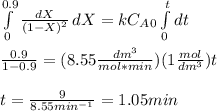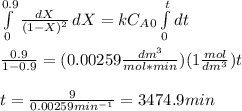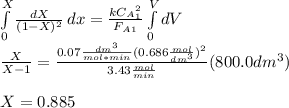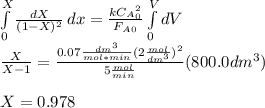
Engineering, 24.03.2020 04:07 rwerjekrryery6750
The liquid-phase reaction follows an elementary rate law and is carried out isothermally in a flow system. The concentrations of the A and B feed streams are 2 M before mixing. The volumetric flow rate of each stream is 5 dm 3 /min, and the entering temperature is 300 K. The streams are mixed immediately before entering. Two reactors are available. One is a gray, 200.0-dm 3 CSTR that can be heated to 77 C or cooled to 0 C, and the other is a white, 800.0-dm 3 PFR operated at 300 K that cannot be heated or cooled but can be painted red or black. Note that k 0.07 dm 3 /mol min at 300 K and E 20 kcal/mol.
a) Which reactor would and what conditions do you recommend? Explaining the reason for your choice. Back up your reasoning with calculations.
b) How long would it take to achieve 90% conversion in a 200 dm3 batch reactor with initial concentrations of A and B at 1 mol/L and operated at 77 °C?
c) What would be your answer to part (b) if at 0 °C?
d) What conversion would be obtained if the CSTR and PFR were operated at 300 K and connected in series? In parallel with 5 dm min of the mixture to each?
e) What can you say about the various reactor types based on the above?

Answers: 3
Another question on Engineering

Engineering, 04.07.2019 18:10
Condition monitoring is a major component of. (clo4) a)- predictive maintenance. b)-preventive maintenance c)-proactive maintenance d)-reactive maintenance.
Answers: 1

Engineering, 04.07.2019 18:10
Items are similar to the free issue items, but their access is limited. (clo5) a)-bin stock items free issue b)-bin stock controlled issue c)-critical or insurance spares d)-rebuildable spares e)-consumables
Answers: 1

Engineering, 04.07.2019 18:20
Have a greater impact on maintenance productivity than any other support group. (clo5) a)-the top management b)-inventory and purchasing c)-sub-contracting d)-cmms
Answers: 2

Engineering, 04.07.2019 18:20
Derive the correction factor formula for conical nozzle i=-(1+ cosa) and calculate the nozzle angle correction factor for a nozzle whose divergence hal-fangle is 13 (hint: assume that all the mass flow originates at the apex of the cone.
Answers: 3
You know the right answer?
The liquid-phase reaction follows an elementary rate law and is carried out isothermally in a flow s...
Questions


History, 29.01.2020 11:53


Mathematics, 29.01.2020 11:53


Mathematics, 29.01.2020 11:53



Health, 29.01.2020 11:53


Mathematics, 29.01.2020 11:53






Arts, 29.01.2020 11:53








![k(T)=k(300K)*exp[\frac{E}{R}(\frac{1}{300K}-\frac{1}{273.15K} )]\\\\k(0^0C=273.15K)=0.07\frac{dm^3}{mol*min} *exp[\frac{20000cal/mol}{1.9872cal/mol*K}(\frac{1}{300K}-\frac{1}{273.15K} )]\\k(0^0C=273.15K)=0.00259\frac{dm^3}{mol*min}\\\\k(77^0C=350.15K)=0.07\frac{dm^3}{mol*min} *exp[\frac{20000cal/mol}{1.9872cal/mol*K}(\frac{1}{300K}-\frac{1}{350.15K} )]\\k(77^0C=350.15K)=8.55\frac{dm^3}{mol*min}](/tpl/images/0560/4913/f56f9.png)







![X_{overall}=\frac{10-[3.43(1-0.885)]}{10} =0.96](/tpl/images/0560/4913/8af0d.png)






